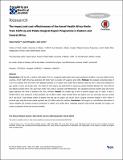The impact and Cost-effectiveness of the Amref Health Africa-Smile Train Cleft Lip and Palate Surgical Repair Programme in Eastern and Central Africa
View/
Publication Date
2017-09-14Type
Article, Journalviews
downloads
Metadata
Show full item record
Abstract/
Cleft lip with or without cleft palate (CLP) is a congenital malformation that causes significant morbidity in low and middle income countries. Amref Health Africa has partnered with Smile Train to provide CLP surgeries since 2006. Methods: We analyzed anonymized data of 37,274 CLP patients from the Smile Train database operated on in eastern and central Africa between 2006 and 2014. Cases were analyzed by age, gender, country and surgery type. The impact of cleft surgery was determined by measuring averted Disability-Adjusted Life Years (DALYs) and delayed averted DALYs. We used mean Smile Train costs to calculate cost-effectiveness. We calculated economic benefit using the human capital approach and Value of Statistical Life (VSL) methods. Results: The median age at time of primary surgery was 5.4 years. A total of 207,879 DALYs were averted at a total estimated cost of US$13 million. Mean averted DALYs per patient were 5.6, and mean cost per averted DALY was $62.8. Total delayed burden of disease from late age at surgery was 36,352 DALYs. Surgical correction resulted in $292 million in economic gain using the human capital approach and $2.4 billion using VSL methods. Conclusion: Cleft surgery is a cost-effective intervention to reduce disability and increase economic productivity in eastern and central Africa. Dedicated programs that provide essential CLP surgery can produce substantial clinical and economic benefits.
Subject/
Burden of disease; cleft lip and palate; cost-benefit; cost-effectiveness; economic benefit; reconstructive surgery.
Publisher
PubmedCollections
- General - GEN [367]

